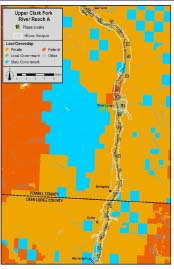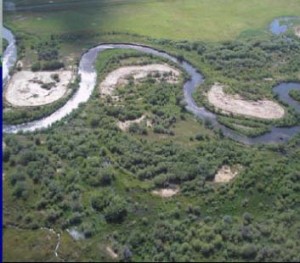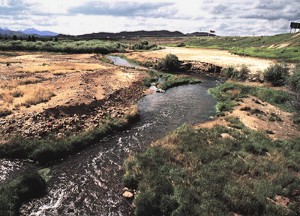 2013 marks the beginning of the clean-up on the mainstem of the Clark Fork River. Restoration efforts to date have focused primarily on Silver Bow Creek. The Clark Fork Operable Unit (an operable unit is the term used for each of a number of separate activities undertaken as part of a Superfund site cleanup) begins at the headwaters of the Clark Fork River at Warm Springs and continues until Milltown. The State of Montana received $123 million dollars from the lawsuit with ARCO to clean up the Clark Fork Superfund site. The majority of the work will take place in the upper section, also known as Reach A, which is a 43-mile stretch extending from Warm Springs to Garrison. Tailings deposits, considered hazardous waste that contain cadmium, zinc, copper, lead, and arsenic, are mixed within the soils of the floodplain and stream banks in this area. Over 300,000 cubic yards of contaminated soil will be removed and streambanks will be reconstructed using bioengineering techniques and native vegetation. Not all of the contaminated soils throughout Reach A will be removed, with priority being given to the areas with deeper deposition of tailings and higher concentrations of metals. The floodplain of the river will be lowered and sediments from the streambed will be removed.
2013 marks the beginning of the clean-up on the mainstem of the Clark Fork River. Restoration efforts to date have focused primarily on Silver Bow Creek. The Clark Fork Operable Unit (an operable unit is the term used for each of a number of separate activities undertaken as part of a Superfund site cleanup) begins at the headwaters of the Clark Fork River at Warm Springs and continues until Milltown. The State of Montana received $123 million dollars from the lawsuit with ARCO to clean up the Clark Fork Superfund site. The majority of the work will take place in the upper section, also known as Reach A, which is a 43-mile stretch extending from Warm Springs to Garrison. Tailings deposits, considered hazardous waste that contain cadmium, zinc, copper, lead, and arsenic, are mixed within the soils of the floodplain and stream banks in this area. Over 300,000 cubic yards of contaminated soil will be removed and streambanks will be reconstructed using bioengineering techniques and native vegetation. Not all of the contaminated soils throughout Reach A will be removed, with priority being given to the areas with deeper deposition of tailings and higher concentrations of metals. The floodplain of the river will be lowered and sediments from the streambed will be removed. 
The restoration of the Clark Fork Operable Unit is a collaborative effort between multiple agencies including the Environmental Protection Agency, the Department of Environmental Quality, the Natural Resource Damage Program, and the National Park Service. The National Park Service is participating in the restoration efforts at the Grant-Kohrs Ranch in Deer Lodge. This collaboration ensures the remedy and restoration are happening concurrently throughout the clean-up process, thereby lowering costs and increasing overall success rate of the restoration efforts. This area will have a long-term (30 year) monitoring plan that includes monitoring of the Superfund Performance Standards for surface water, groundwater, and vegetation. In addition, the success of the restoration efforts will be monitored by examining stream bed sediments and nutrient concentrations, as well as periphyton (a mixture of algae, cyanobacteria, heterotrophic microbes, and detritus), macroinvertebrate and fish populations.
For more information regarding the clean-up of the Clark Fork River, contact:
Brian Bartkowiak, DEQ
Clark Fork River
Project Officer
bbartkowiak@mt.gov
(406) 841-5043
Katie Garcin, DEQ
CFR Project Technician
kgarcin@mt.gov
(406) 846-5042
Jeni Garcin, DEQ
Public Information Officer
jgarcin2@mt.gov
(406) 841-5016
Tom Mostad, NRDP
Restoration Manager
